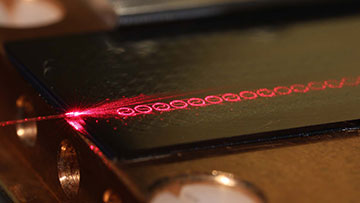
Researchers have built a waveguide from a series of spirals etched into a silicon nitride chip, which they show can amplify near-infrared laser light over bandwidths 10 times those of current devices. [Image: Chalmers University of Technology, Vijay Shekhawat]
Scientists in Sweden have reportedly shown how to amplify laser light at telecom wavelengths over very high bandwidths by exploiting nonlinearities in single-mode spiral-shaped waveguides on a photonic chip (Nature, doi: 10.1038/s41586-025-08824-3). They say that their scheme could improve telecommunications and also be applied to medical imaging and material characterization.
Exploiting nonlinearities
With the rise of social media, video streaming and artificial intelligence, traffic on the internet looks set to grow significantly in the years ahead. One stumbling block in meeting this demand is the fairly limited bandwidth of optical amplifiers, which are placed at regular intervals along fiber links to maintain a high signal-to-noise ratio.
Rather than try and amplify signals using stimulated emission, several researchers are instead looking to exploit the nonlinear phenomenon of four-wave mixing. The basic idea is to direct a weak signal and strong pump beam at a medium with third-order nonlinearity. This yields both a more powerful signal at the output and an idler beam.
Amplifying light in this way relies on satisfying a number of criteria simultaneously, one of which is anomalous dispersion—when a medium's refractive index increases as the incident radiation's wavelength goes up. This condition is needed to ensure phase matching between the signal and pump waves, resulting in large gain and bandwidth.
Numerous groups have shown how to achieve anomalous dispersion in nonlinear integrated waveguides with high refractive-index contrast, doing so with a variety of different materials including silicon, aluminium gallium arsenide and graphene. However, they relied on waveguides with multiple optical modes. These modes tend to couple to one another, which saps power from both signal and pump waves and therefore decreases gain and bandwidth as well as distorting modulated signals.
Single-mode anomalous dispersion
In the latest work, Peter Andrekson and colleagues at Chalmers University of Technology show it is possible to achieve anomalous dispersion with just a single mode. Their trick was to optimize a waveguide's three-dimensional shape, concentrating not only on its cross section but also its longitudinal path. They found that by bending the waveguide into a spiral shape, they could cut off higher-order modes while retaining anomalous dispersion.
They found that by bending the waveguide into a spiral shape, they could cut off higher-order modes while retaining anomalous dispersion.
After carrying out computer simulations, the researchers etched two types of waveguide from a layer of silicon nitride deposited on a silicon wafer. Both types consisted of multiple copies of the same basic unit—a spiral with a 300-nm-thick, 1.9-µm-wide two-layered cross section—joined together by short straight sections. One waveguide featured just 12 spirals in an 18-cm-long structure, while the other boasted 68 spirals to yield a total length of 56 cm.
Andrekson and colleagues exposed the 56-cm-long waveguide to a pump wave at 1551 nm and a signal with variable wavelengths. The team showed that it could achieve a gain of a few decibels across a broad range of signal wavelengths, from about 1400 to 1700 nm. This roughly 300 nm bandwidth is about 10 times that of existing optical amplifiers.
The researchers also studied the effect of their scheme on data transmission. When modulating the intensity of the signal beam at 10 gigabits/s, they found that amplification degraded neither the signal nor idler waves.
Future directions
The researchers point out that the technology is not yet ready for real-world applications. In particular, they are looking to push the amplification up significantly, to around 20 dB. Andrekson reckons that should be fairly easy to fix by extending the length of the waveguides to at least 2 m, saying that he and his colleagues have already made waveguides 1.4 m long. But he takes nothing for granted. “There are always aspects to consider in a university clean room like ours that can cause imperfections and give rise to performance yield concerns,” he explains.
The researchers also believe that they could extend the scheme to other wavelengths by integrating additional spirals on the same wafer. Not only might amplifiers be made across the transmission spectrum of the silica fibers used in telecommunications, they say, but also in the visible and the infrared ranges. As such, they argue, the technology might one day be used for medical applications such as diagnosing diseases, visualizing internal organs or guiding surgical operations, as well as inspecting materials or manufactured components.
